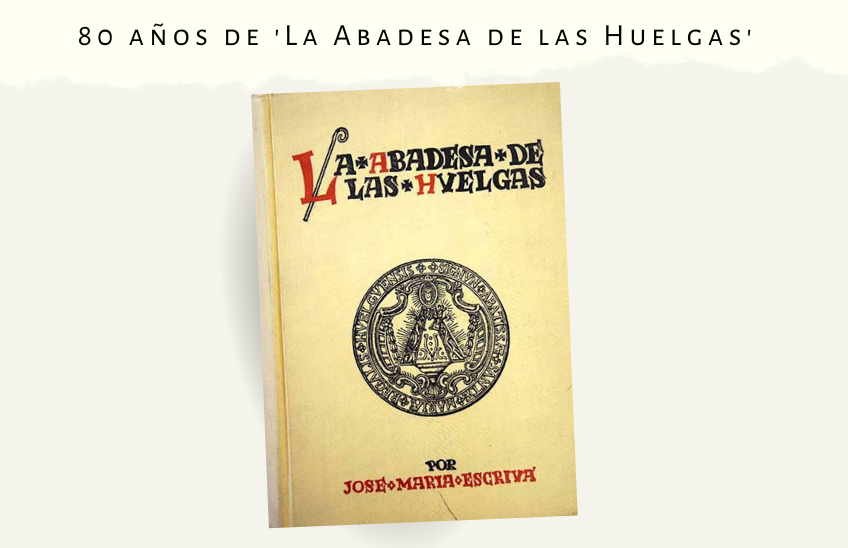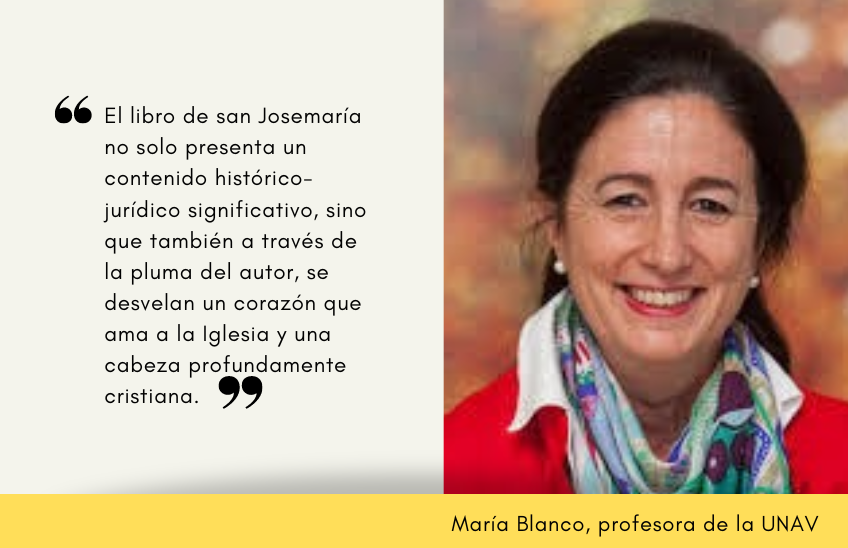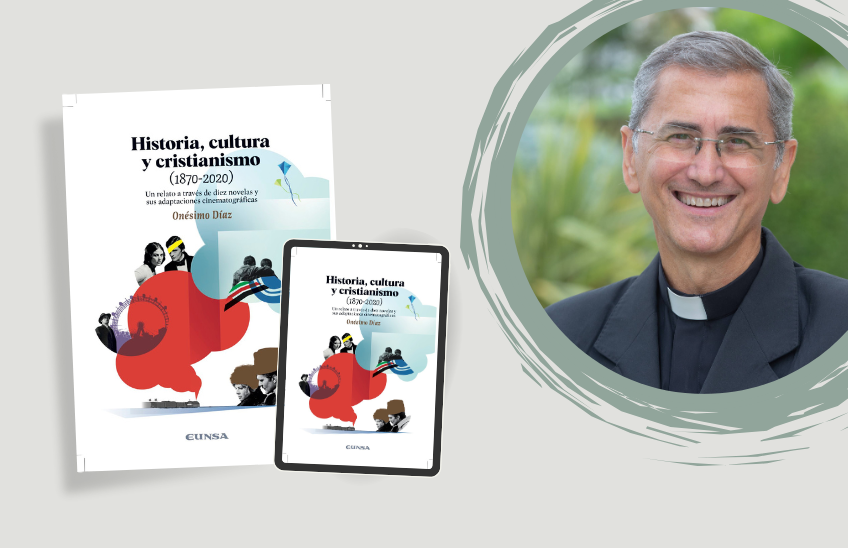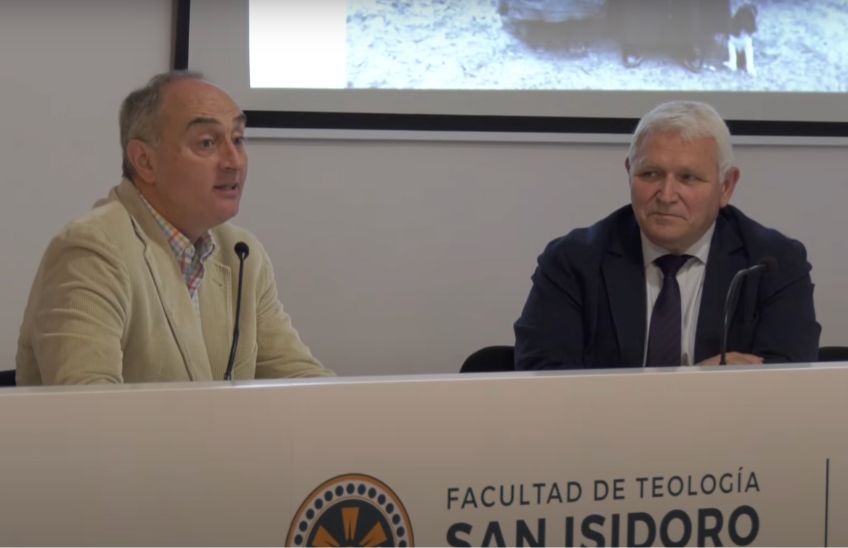80 years of "The Abbess of Las Huelgas": St. Josemaría Escrivá and his historical-legal bequest
In 1944, St. Josemaría Escrivá published "The Abbess of Las Huelgas," a work less known to the general public, but popular and appreciated in the field of History of Law and in the historical programs of study on women. On the eightieth anniversary of its publication, the Center of programs of study Josemaría Escrivá interviewed one of the co-authors of the critical-historical edition of the book, Professor María Blanco of the University of Navarra.

26 | 03 | 2024
On March 31, 1944, St. Josemaría Escrivá published his work The Abbess of Las Huelgas. The author is widely known in the spiritual sphere. This work reveals his interest in disciplines such as law and history, as he delves into the figure of the abbess of the Monastery of Las Huelgas (Burgos), who exercised quasi-episcopal jurisdiction for centuries over a vast territory Spanish. The abbess, in addition to possessing civil authority over vast territories thanks to royal privileges, also held in her domain a canonical power similar to that of the bishops over the Christian faithful in her domain, except in matters requiring sacred order.
This book sheds light on a historical episode and, also, sample St. Josemaría's deep appreciation for the university research and his constant interest in ecclesial realities. The reader is immersed in the intellectual and spiritual bequest of the author.
On the framework of the eightieth anniversary of the publication of 'The Abbess of Las Huelgas,' the Center at programs of study Josemaría Escrivá interviewed María Blanco, co-author of the critical-historical edition of the book published in 2016. This work was conducted at partnership with María del Mar Martín, full professor of State Ecclesiastical Law at the University of Almería. The authors analyze the biographical journey undertaken by Escrivá in his research and establish connections between his work and the fundamental message of Opus Dei: the sanctification of the professional work .
María Blanco, professor of State Ecclesiastical Law at the University of Navarra, is the author of five monographs of historical-legal content, numerous articles and member of the scientific committee of several journals, as well as Corresponding Academician of the Royal Academy of Jurisprudence and Legislation and member of the committee directive of the Consociatio Iuris Canonici Promovendo.
What was the main interest that led St. Josemaría Escrivá to undertake a study of the abbess of the Monastery of Las Huelgas?
During the Spanish Civil War, St. Josemaría decided to resume his thesis after arriving in Burgos after crossing the Pyrenees. However, due to the war he had lost all the material he had worked with in previous years in Madrid in a research on the ordination of mestizo priests in Spanish America. It was probably then that a priest, with whom he met again by chance in Burgos, suggested that he take advantage of his stay in the city to investigate the jurisdiction of the Monastery of Las Huelgas, which was very close by and where he could access the material of file. With this suggestion in mind and using the documents available at the monastery, St. Josemaría decided to take up the research project again.
Years after defending the thesis , Escrivá decided to publish a book on this topic because he was well acquainted with the subject. He expanded the documentation available and went deeper into the research. Finally, in 1944, he published the book 'La Abadesa de las Huelgas'.
Together with María del Mar Martín, with whom I worked on the critical edition of the book, we think that St. Josemaría was probably motivated to write this work for reasons of exemplarity. At that time, he was working apostolically among university students. He transmitted to them the meaning of the sanctification of the professional work .
We think that it would also be an example to his future priest sons, to whom he was going to ask the realization of a thesis in his ecclesiastical programs of study . Ultimately written request, and as reflected in many passages, he sought to give doctrine.
What is the importance of the figure of the Abbess of the Monastery of Las Huelgas in the study of Canon Law and in ecclesiastical history?
The figure of the Abbess of the Monastery of Las Huelgas is of great interest in different areas: that of the History of Law, the history of women and, undoubtedly, the Canon Law.
The Monastery of Las Huelgas was founded in 1187 by King Alfonso VIII of Castile and his wife Leonor de Plantagenet. It was intended to house the daughters of nobles. Women who entered this monastery often brought dowries that included land and benefits granted by royalty, such as tax exemptions. Over time, the monastery and its jurisdiction expanded enormously, encompassing vast tracts of land ranging from what is now Cantabria to the province of Toledo.
The authority of the abbess also grew with the extension of the monastery. Originally limited to the area of the convent, her influence extended as she took on new lands and towns (often donated by the kings) and, with them, took on judicial and administrative actions in the new territories. The abbess intervened in the resolution of disputes and appointed local officials, with the support of the population and without significant civil service examination due to the royal origin of the territories. Curiously, she intervened in the resolution of conflicts originated by ecclesiastics or between ecclesiastics.
Over time, these practices were consolidated into what is known as juridical custom, a form of law based on continued usage. The authority of the abbesses of Las Huelgas, in both civil and ecclesiastical matters, was equated to that of a queen in civil matters and that of a bishop in ecclesiastical matters; the latter with regard to the appointment of priests to position of parishes or the ability to receive solemn vows not only from the nuns of their monastery, but also from an adjacent monastery of friars.
That is to say, the influence of the abbess of the Monastery of Las Huelgas transcended the merely ecclesiastical, leaving a significant bequest in the History of Law and the society of the time.
What were the main contributions of this research made by St. Josemaría?
From a technical-legal perspective, Escrivá's research highlights the importance and force of custom in the field of Canon Law. Custom, as source of the law, manifests itself as a continued use by a community, unless expressly reproved by the legislator.
St. Josemaría's book not only presents a significant historical-legal content, but also, through the author's pen, reveals a heart that loves the Church and a profoundly Christian head. In his pages, he highlights the importance of obedience to the Pope as a fundamental part of the Christian faith. One paragraph in particular highlights this perspective when the author describes how the abbess of Las Huelgas informs her nuns that the Pope, by means of the bull Quae diversa, put an end to her quasi-episcopal jurisdiction. Escrivá relates it this way:
"It is precisely now, at the precise moment when the all-encompassing power of the Abbess is incorporated into the book of History as an extraordinary event that cannot be repeated, even though it is adorned with several centuries of splendor, that the figure of this Most Illustrious Lady reaches its greatest prestige: that of her fidelity to the Hierarchy of the Church" (La Abadesa de las Huelgas, ed. Crítico-histórica, n. 54 a).
What impact has this book had on the scientific and academic community since its first edition in 1944 and its subsequent reprints in 1974 and 1988?
I was pleasantly surprised to discover that this book has become a reference letter in dealing with the topic of women in the Church from a historical perspective. In the realm of history, it quotation widely, but what surprised me most is its preeminence in the Anglo-Saxon world. While some of these quotes may not be entirely accurate, it is B how the book has captured attention and interest in these academic circles.

What were the main challenges in critically editing the book?
The biggest challenges arose due to the lack of background information on a book of these characteristics. Initially, there seemed to be little material available, so we had to conduct an exhaustive search in various archives.
Among others, the diocesan file of Burgos, that of the Prelature and the file staff of María Jiménez Salas in the Library Services Tomás Navarro, belonging to the Center for Human and Social Sciences of the CSIC.
We reviewed, for example, the liturgical calendars used by St. Josemaría in the 1940s to determine his visits to Burgos. We also read the diaries of the centers, especially those of Diego de León, where St. Josemaría lived. This provided us with valuable clues about his activities. For example, we discovered how St. Josemaría had read the book's prologue at an informal meeting with students and asked for their opinions. One of them, a medical student, warned him that there were some words that sounded in verse, and the author took up the suggestion.
At the Monastery of Las Huelgas we were given ample facilities to access file and examine the book of signatures. With the help of financial aid of María Jesús Coma, an expert in the study of St. Josemaría in Burgos, we were also able to investigate the file of the cloister and have access to the correspondence with St. Josemaría.
On the other hand, logically, we had to study in depth all the juridical-canonical questions raised in the book and rigorously analyze the doctrinal opinions of the most famous canonists.
It was a very interesting process that involved assembling a jigsaw puzzle of scattered information and the invaluable assistance of many people from different fields, financial aid .



